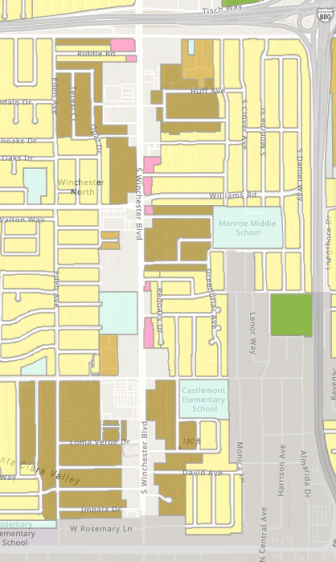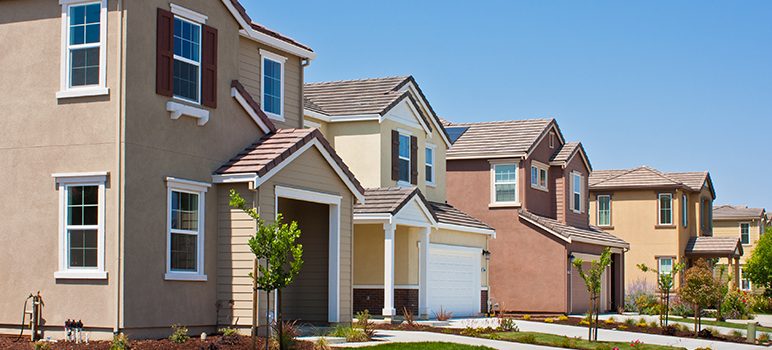A handful of pretty good laws for renters in California were signed into law this week. No longer can landlords discriminate against voucher holders, nor can they evict tenants without cause, provided the building is older than 15 years and the tenant has lived in the unit over a year. And by allowing homeowners to build up to two in-law units on their property, California basically banned single-family home zoning, as Oregon and Minneapolis have earlier this year.
But Sacramento has still failed to pass any legislation to meaningfully address the root of the housing problem: job creation well in excess of housing production for years, for decades. Allowing homeowners to build in-law flats is unlikely to put much of a dent in the jobs-to-housing ratio.
The housing shortage causes misery, empties the pockets of renters and fills the streets with an unsheltered population. People living in the creeks and parks are just the tip of iceberg. Local officials estimate that the number of people living in their cars has tripled over the past two years and that 40 percent of residents are at risk of displacement.
Silicon Valley, epicenter of the jobs-to-housing imbalance, home to Google and Apple, continues to grow. Santa Clara County added another 4,900 jobs in August, accounting for a fourth of California’s total new jobs. No longer able to afford rent, low-income residents are displaced by well-paid newcomers.
Too many suburban homeowners of Silicon Valley feel there isn’t any space left in their neighborhoods. In one sense, the suburbs have always been exclusive; American suburbia itself was created through a synergy of federal and local laws with real estate and banking interests uniting under the shared goal of white supremacy.
Today, the suburbs of Silicon Valley are full in the sense that the roads are clogged. The commutes are some of the worst in the country.
San Jose Mayor Sam Liccardo declared earlier this year that housing is his top priority. Aside from complaining that neighboring jurisdictions aren’t doing their part to build housing (a favorite example: Cupertino permitted 27 new units of housing when Apple’s spaceship began hosting over 10,000 employees in 2017, after permitting zero units in the five years prior), Liccardo hasn’t done much to stimulate housing production.
What’s worse is that Liccardo misdirects the housing production conversation into support for anti-tenant policies, such as cutting protections for renters in buildings to be redeveloped. Last month, the City Council voted to extend incentives to developers for downtown high-rises. But the council is ignoring the biggest hurdle to housing construction, low density-zoning: 94 percent of residential land in San Jose is zoned for detached single family homes.
If he really wants to, Mayor Liccardo do more to alleviate the housing shortage in Silicon Valley than any other politician in California in a way that benefits both tenants and developers while desegregating the city and strengthening the city’s tax base: upzoning and fast-tracking residential development closer to the tech companies in western San Jose. If Mayor Liccardo is really serious about addressing the housing shortage, why not let (thousands) more apartment buildings in western San Jose?
Cutting Red Tape
Developers complain about the costly, burdensome process to build housing in San Jose. One developer told the council that “luxury apartment rents” would have to climb another 25 percent to entice more development. A report by the Silicon Valley Business Journal last year found that housing isn’t profitable to build except in West San Jose, which yields a 19 percent profit margin on new housing construction.
Why is nobody talking about upzoning in West San Jose, where it is already profitable for developers to build? Letting West Side homeowners sell their Prop. 13-subsidized single-family homes to developers to turn into condos and apartments would fill the city’s coffers with property tax revenue, which surely appeals to a fiscal hawk like Liccardo.
The problem is that a critical mass of selfish and change-averse homeowners controls the political system, pushing back against increased density and more housing. These homeowners act like building an apartment building in their neighborhood is violence and react to housing proposals with contempt for the poor and vulnerable, like the Willow Glen residents whose opposition shuttered the Hope Village homeless encampment, and a blindness to the community’s future, such as the 5,000 Almaden signatories who opposed affordable housing for teachers on school-owned land last year out of concern for its impact on traffic and home values.
To ease the worried, wealthy suburbanites, downtown developers do outreach events in San Jose’s wealthy suburbs to promise their exclusive enclaves will remain intact. The interests of tech, developers and renters for increased housing production are subordinate to wealthy homeowners, many of whom, having been homeowners for decades, erode the cities’ tax base by artificially low property taxes.
Segregation in San Jose

San Jose's General Plan map of the Winchester Urban Village.
A typical American city, San Jose’s housing market is segregated by income and race between the lower-income East Side and the wealthy white west. Explicitly racist housing practices have long been abolished, but insidious housing policies remain to this day. Just look at this map of San Jose’s General Plan in West San Jose along Winchester.
Several years ago, the council created “Urban Villages” to promote development within demarcated zones. In drawing the boundaries of the Urban Village in West San Jose along Winchester, the “Urban Residential” tracks (i.e. apartment buildings with low-income tenants) are included in the Urban Village, but the adjacent single-family home neighborhoods are conspicuously excluded.
The jagged boundaries of the Winchester Urban Village invite developers to redevelop low-income neighborhoods–tear them down, displace the residents, then build new buildings–but not in the suburbs. The message here is clear: renters shall bear the burden of development, not homeowners. The Winchester Urban Village does not allow a homeowner, looking to cash out of the area, to sell her single-family house to redevelop into an apartment building.
Additionally, only the East Side has form-based zoning, which makes it easier for projects to be approved. Overt racism may no longer be allowed, but since the city encourages redevelopment of the small portions of land reserved for apartment buildings, it’s no wonder that the majority of the population at risk to displacement are Latino, African American and Vietnamese.
A Stevens Creek Promenade
In early June as part of the four-year General Plan review, Liccardo proposed to increase density by allowing fourplexes in some suburban neighborhoods near existing medium-density neighborhoods (i.e. where duplexes and triplexes are already allowed) and Urban Villages. It was smaller peanuts than Sacramento’s legislation liberalizing in-law units.
The solution to Silicon Valley’s housing problem, for those who do not want to stop job growth or evict the tech companies, is as simple as amending San Jose’s general plan and zoning laws to increase density and enable a quicker application process (i.e. form-based zoning) for housing projects in the wealthy parts of town, especially West San Jose, Willow Glen, the Rose Garden and Almaden.
Between Apple’s campus in Cupertino (close to West San Jose’s border) and San Jose’s most frequented shopping centers lies a vast swath of suburbia. If Cupertino won’t house its workforce, why not allow dense development in West San Jose to provide housing for Apple employees and ease congestion? A visionary mayor of San Jose would densify the entire westside and advocate for BART to connect downtown to Santana Row to Cupertino along Stevens Creek, instead of BART’s proposed line from downtown to Santa Clara, redundantly alongside Caltrain.
Simply by letting developers build apartments in wealthier parts of San Jose, Liccardo has the opportunity to desegregate San Jose to allow renters (who tend to be poorer and people of color) to live in neighborhoods with homeowners (who tend to be wealthier and whiter). Reforming the General Plan and zoning laws would not solve the crisis because it would not generate enough housing for the most vulnerable members of our community—for that we would need a gross receipts tax on large corporations earmarked for homelessness like San Francisco did last year. Such a reform would do far more to alleviate the jobs-housing imbalance than Liccardo’s main strategies of stripping away tenant protections and pointing the finger at neighboring cities for insufficient housing.
Instead, Liccardo practices the politics of triangulation, pretending to support an end to single-family zoning while on the talking circuit but without delivering any policies to yield the housing production the needed scale
On Thursday, Google unveiled its designs for a campus in San Jose on downtown land it purchased from the city last year for $110 million (a smaller figure than the $135 million it doled out a few months prior out to settle a lawsuit against two executives accused of sexual harassment). If it’s too much to ask Google to pay for the housing San Jose needs, can we at least allow single-family homeowners to sell their homes to developers to build into apartment buildings in western San Jose?
Tom Skinner is a lawyer who lives and works in downtown San Jose. Opinions are the author’s own and do not necessarily reflect those of San Jose Inside. Send op-ed pitches to
je*******@me*******.com
.


> Opinions are the author’s own and do not necessarily reflect those of San Jose Inside.
Dear Mr. Inside:
I think you disclaimer is pathetically meek and timid, and allows the author to hope that someone might actually take him seriously.
How about this:
“The opinions offered up by this commercial opinion monger working for God knows who make no sense whatsoever, but we printed them just because we’re nice guys and our readers might be amused to learn what craven, ignorant, and disturbed people are trying to get them to believe.”
This is so true. Common City think about it now. There’s even the Coyote Valley that they’ve put in green hell.
My neighborhood in west San Jose isn’t filled with mean old white homeowners clinging to their Prop-13’ed castles, increasingly it’s full of young families and immigrants from India and China. Most of the retired white people have sold on our street have sold their homes in the last few of years. Also, this isn’t a neighborhood of McMansions, we are talking about modest 1960s tract homes on smallish lots. The families here (again, increasingly Asian, not white) have have sacrificed to purchase a home, and are paying their full boat of property taxes, as well as substantial mortgages. And you are suggesting that they should happily allow multistory homes to be built looming over their backyards, destroying their equity, and creating a neighborhood parking and traffic nightmare? Do the schools even have capacity to educate thousands of new children moving into the area?
Also, don’t expect the existing homeowners to stick around for very long in this scenario… they will start moving elsewhere, taking their high-achieving children and all the resources that they invest in the community, and the jobs will go with them, leaving behind underfunded, overcrowded schools and a city struggling to find the resources to provide basic services. So if that sounds like a utopia to you, well, enjoy the future.
The author started to touch on this, but did not go deep enough. SJ’s entitlement costs are rapidly approaching $100k/unit. Most of this is in up-front costs, years before a project is ready to start collecting rent. This is an ROI killer, especially when its clear the legislative trend (locally & state) is to limit profit of housing providers.
More legislation and nanny-state managing of the housing shortage is not needed. Exactly the opposite is needed. Get government out of the way. Decades of gov’t intrusion & crony capitalism that favors a handful of developers is exactly why we have a housing shortage today.
No new bill with more requirements is going to fix that.